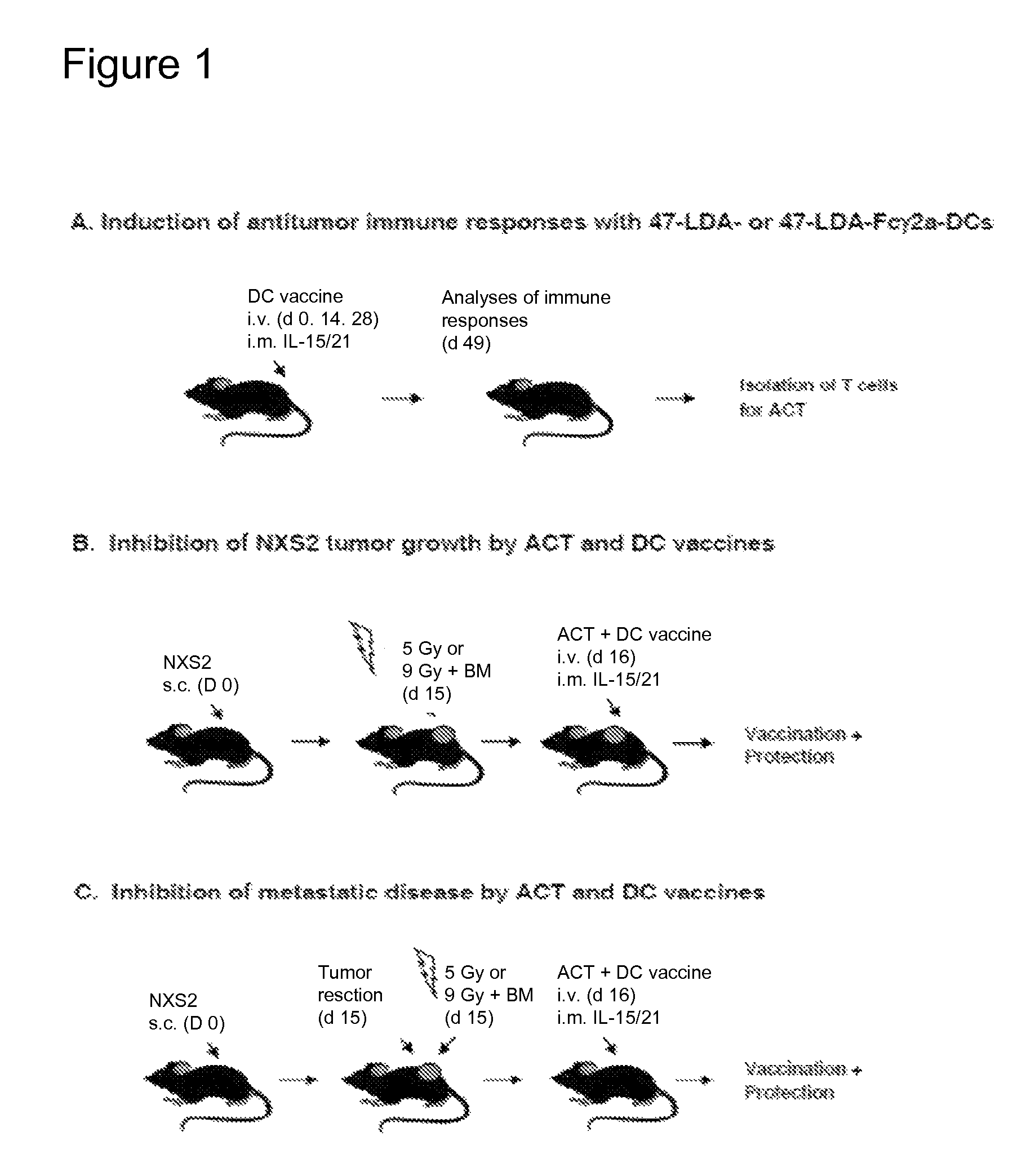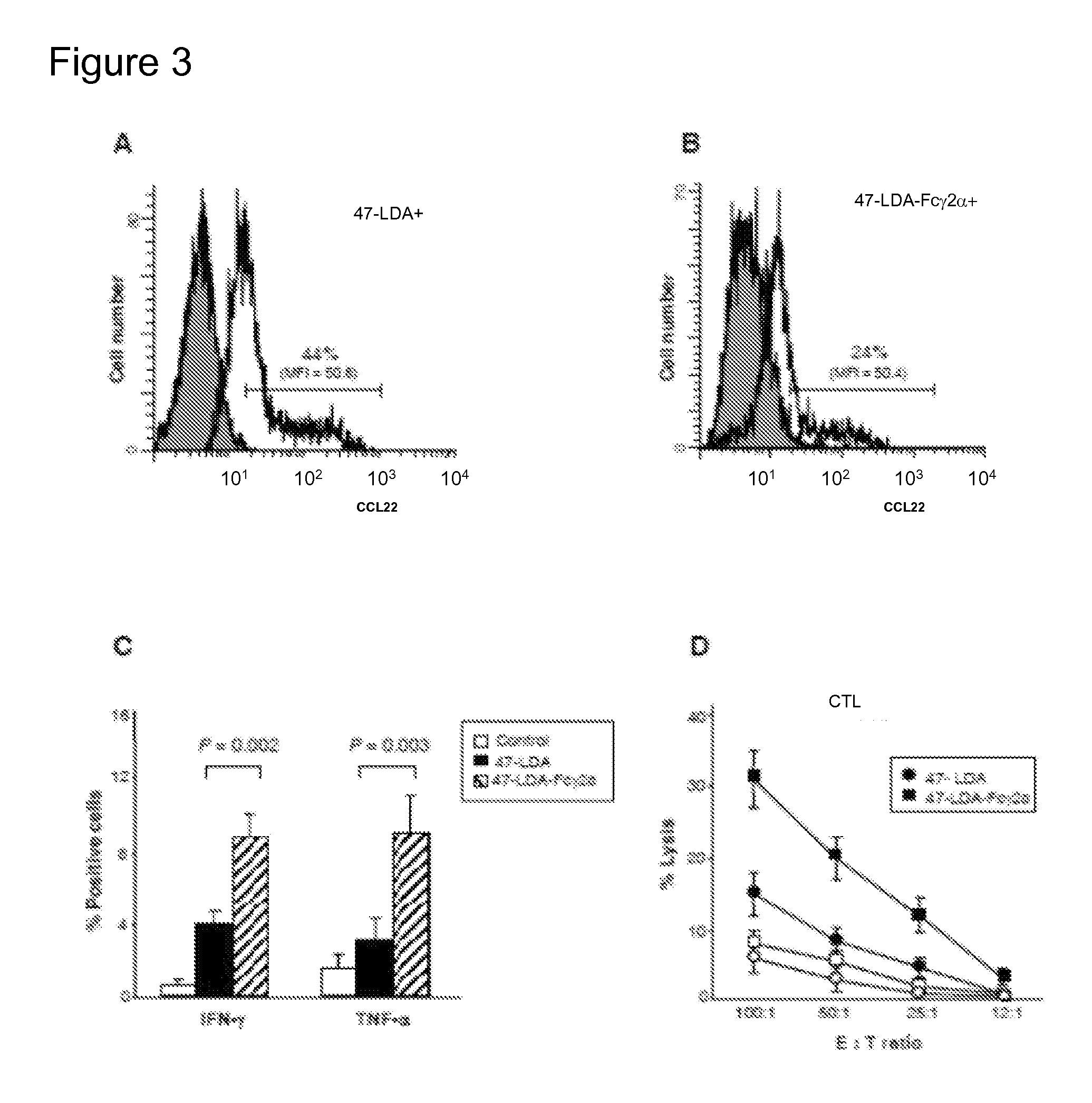Methods and compositions containing Fc fusion proteins for enhancing immune responses
a technology of fusion proteins and immune responses, applied in the field of modulating immune responses, can solve the problems of elusive application of cancer vaccines to treat patients
- Summary
- Abstract
- Description
- Claims
- Application Information
AI Technical Summary
Benefits of technology
Problems solved by technology
Method used
Image
Examples
example 1
[0055]This Example provides a description of the materials and methods used to obtain data presented herein.
Animals and Cell Lines
[0056]Female A / J mice, 6-8 weeks of age, were obtained from the Jackson Laboratory (Bar Harbor, Me.). The experimental procedures were performed in compliance with protocols approved by the Institutional Animal Care and Use Committee of the Roswell Park Cancer Institute. The murine NXS2 neuroblastoma cell line (provided by Dr. R. A. Reisfeld, The Scripps Res. Inst. La Jolla, Calif.) is a hybrid between the GD2-negative C1300 murine neuroblastoma (A / J background) and GD2-positive murine dorsal root ganglioma cells. The hybrid cell line was shown to be MHC class I syngeneic to A / J mice by its H-2Kk-positive / H-2Kb-negative phenotype (Lode, H. N., R. Xiang, T. Dreier, N. M. Varki, S. D. Gillies, and R. A. Reisfeld. 1998. Natural killer cell-mediated eradication of neuroblastoma metastases to bone marrow by targeted interleukin-2 therapy. Blood 91: 1706-1715.)...
example 2
Characterization of Murine 47-LDA-Fcγ2a Fusion Protein
[0069]The murine 47-LDA-Fcγ2a fusion protein was generated by inserting the relevant coding sequence [including the tissue plasminogen activator secretory (tPA) signal sequence, two universal Th peptides, and the 47-LDA mimotope] in-frame between the hEF1-HTLV promoter and the mouse IgG2a Fc region of the pFUSE-mIgG2Aa-Fcl vector using the EcoRI and BglII restriction enzyme cleavage sites. After sequencing of the 47-LDA-Fcγ2a construct to confirm the presence of an uncorrupted open reading frame, immunofluorescence staining of 47-LDA-Fcγ2-transfected 293T cells with 14G2a mAb followed by a flow cytometry analysis was done 48 h after transfection to determine the expression of the fusion protein (not shown). The secretion of the fusion protein from 47-LDA-Fcγ2a stable transfectants, selected in zeocin-containing medium, was confirmed by immunoblotting of the culture supernatant with 14G2a mAb. As shown in FIG. 2A, a prominent band...
example 3
[0081]This Example provides a demonstration of one embodiment of the method used to inhibit the growth of two distinct tumors in a clinically relevant mouse model.
[0082]We expressed a novel anticancer agent CTCE-9908 that is the CXCR4 chemokine receptor antagonist. This peptide antagonist of CXCR4 (amino acid sequence: KGVSLSYR-K-RYSLSVGK; SEQ ID NO:5) is a dimer of the N-terminal region of SDF-1 (CXCL12) chemokine CTCE-9908 blocks the interaction of the CXCR4 receptor with CXCL12, which is critical in the infiltration of organ tissue by metastatic cells, thereby reducing tumor metastasis. CXCR4 receptors are expressed on many tumor cell types. The CTCE-9908 peptide has been developed by Chemokine Therapeutics, Vancouver, Canada and been used in Phase I / II clinical trials in late stage cancer patients.
[0083]We expressed a CTCE-9908 peptide (SEQ ID NO:6) in the context of the activating murine and human IgG2a and IgG1 Fc fragments, respectively, using DNA plasmids or oncolytic recomb...
PUM
| Property | Measurement | Unit |
|---|---|---|
| volume | aaaaa | aaaaa |
| time | aaaaa | aaaaa |
| molecular mass | aaaaa | aaaaa |
Abstract
Description
Claims
Application Information
 Login to View More
Login to View More - R&D
- Intellectual Property
- Life Sciences
- Materials
- Tech Scout
- Unparalleled Data Quality
- Higher Quality Content
- 60% Fewer Hallucinations
Browse by: Latest US Patents, China's latest patents, Technical Efficacy Thesaurus, Application Domain, Technology Topic, Popular Technical Reports.
© 2025 PatSnap. All rights reserved.Legal|Privacy policy|Modern Slavery Act Transparency Statement|Sitemap|About US| Contact US: help@patsnap.com



